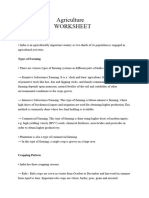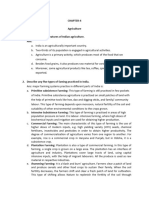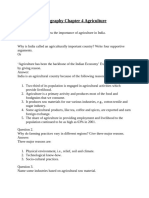Agriculture Class 10 Important Questions and Answers Chapter 4 PDF
Uploaded by
Abhijit ChakrabortyCopyright:
Available Formats
Agriculture Class 10 Important Questions and Answers Chapter 4 PDF
Uploaded by
Abhijit ChakrabortyOriginal Title
Copyright
Available Formats
Share this document
Did you find this document useful?
Is this content inappropriate?
Copyright:
Available Formats
Agriculture Class 10 Important Questions and Answers Chapter 4 PDF
Uploaded by
Abhijit ChakrabortyCopyright:
Available Formats
Important Questions for Class 10 Social Science
Geography Chapter 4 – Agriculture
1. Which of the following is a rabi crop?
(a) Rice
(b) Millets
(c) Gram
(d) Cotton
Ans: (c) Gram
2. Mention some of the states of India where Intensive Subsistence Farming is practised.
Ans: Intensive subsistence farming is found in states like Punjab, Haryana, Uttar Pradesh, and
West Bengal. In these areas, farmers use small pieces of land and put in a lot of hard work and
resources to grow crops. This farming method is common where there are many people, so it's
important to produce a lot of food from limited land. It often involves growing crops like rice,
wheat, and pulses. This approach helps meet the high food demands in densely populated
regions.
3. Give some examples of crops which may be commercial in one region and may provide
subsistence in another region.
Ans:
• Rice: In places like Japan and Thailand, rice is grown to sell and export. In other areas,
like parts of Africa and Asia, rice is mostly grown to feed local families.
Class X Social Science www.vedantu.com 1
• Wheat: In the United States and Canada, wheat is grown to sell around the world. In
countries like India and Pakistan, it’s often grown to provide food for local people.
• Sugarcane: In Brazil and Cuba, sugarcane is a major crop for making sugar and
ethanol. In other regions, like some parts of India, it’s mainly grown for local use.
• Cotton: In the United States and China, cotton is grown to sell for making clothes. In
parts of West Africa, cotton is grown more to support local needs and livelihoods.
4. Name one important beverage crop and specify the geographical conditions required
for its growth.
Ans: One important beverage crop is tea. It needs specific conditions to grow well. Tea plants
require a warm and humid climate, with temperatures ranging from 20°C to 30°C. They thrive
in well-drained, acidic soils, ideally with a pH between 4.5 and 5.5. Tea plants need ample
rainfall, about 1500 to 2500 mm per year, and they grow best in high-altitude areas where
there is mist or cloud cover. This environment helps protect the plants from too much heat and
direct sunlight.
5. Enlist the various institutional reform programmes introduced by the government in
the interest of farmers.
Ans:
• Minimum Support Price (MSP): Guarantees a minimum price for crops to ensure
farmers get a fair return.
• National Bank for Agriculture and Rural Development (NABARD): Offers loans
and support to improve rural and farming infrastructure.
• Pradhan Mantri Fasal Bima Yojana (PMFBY): Provides crop insurance to protect
farmers from losses due to bad weather or pests.
• Soil Health Management (SHM): Works on improving soil health by testing and
adding needed nutrients.
Class X Social Science www.vedantu.com 2
• Kisan Credit Card (KCC): This makes it easier for farmers to get loans for their
farming needs.
• Rural Infrastructure Development Fund (RIDF): Helps build and improve rural
facilities like irrigation systems and roads.
6. Describe the impact of globalisation on Indian agriculture.
Ans: Impact of Globalization on Indian Agriculture:
• Increased Productivity: New farming techniques, better seeds, and technology have
led to higher crop yields.
• Access to International Markets: Farmers can sell their produce globally, often
getting better prices.
• Increased Competition: Foreign products can compete with local produce, sometimes
lowering farmers' incomes.
• Shift to Cash Crops: More focus on cash crops for export can reduce the production
of essential food crops.
• Wider Gap Between Farmers: Large-scale farmers benefit more from globalization,
widening the gap with smaller, less resourceful farmers.
• Market Access Issues: Small farmers may struggle to compete in global markets due
to limited resources.
7. What are the geographical conditions needed for rice to grow? Explain.
Ans: Rice needs specific conditions to grow well. It requires a warm climate, with
temperatures between 25°C to 35°C. It also needs a lot of water, so it grows best in flat areas
that can hold water. The soil should be rich and able to keep water. Rice is usually grown in
fields called paddies, which are kept flooded. These conditions help rice plants grow and
produce a good crop.
Class X Social Science www.vedantu.com 3
8. What are the 3 main features of a ‘Rabi crop season?’
Ans: The three main features of the 'Rabi crop season' are:
• Timing: Rabi crops are grown during the winter season, typically from October to
March. They are sown after the monsoon season and harvested in the spring.
• Climate: Rabi crops require a cool, dry climate to grow. They thrive in the winter
months when temperatures are lower, which helps in the development and yield of the
crops.
• Water Supply: Rabi crops rely mainly on irrigation as they are grown after the
monsoon rains have ended. Farmers need to provide additional water through irrigation
to ensure proper growth and harvest.
These features make the Rabi season distinct from other crop seasons and are crucial for
successful farming.
9. Define the 3 main features of a ‘Kharif crop season’.
Ans: The Kharif crop season has three main features:
• Timing: The Kharif season starts with the monsoon rains and runs from June to
October. This season benefits from the heavy rainfall and warm weather.
• Crops: During this season, farmers grow crops that need a lot of water. Common Kharif
crops include rice, maize, and cotton. These crops thrive in the wet conditions of this
season.
• Harvesting: Kharif crops are usually harvested from September to December. The
crops are gathered after the monsoon rains, as they have had enough water to grow well.
These features make the Kharif season an important time for growing crops that rely on rain
and warm temperatures.
Class X Social Science www.vedantu.com 4
10. Name any two major fibre crops grown in India. Describe the conditions required to
grow these two crops.
Ans: The major fibre crops grown in India are cotton and jute.
• Cotton requires a warm climate with plenty of sunshine and well-drained soil. It grows
best in regions with moderate rainfall and temperatures between 20°C and 30°C.
• Jute needs a hot and humid climate with abundant water. It grows well in areas with
high rainfall and temperatures around 25°C to 35°C. The soil should be loamy and able
to retain moisture. Both crops need proper irrigation and pest control to thrive.
11. Mention any five institutional reform programmes introduced by the government in
the interest of the farmers.
Ans:
• Pradhan Mantri Fasal Bima Yojana (PMFBY): This program gives insurance for
crops if they are damaged by natural events or pests.
• National Agriculture Market (e-NAM): An online platform where farmers can sell
their crops to get better prices in different markets.
• Soil Health Management (SHM): This scheme improves soil health with organic
fertilizers and soil testing.
• Pradhan Mantri Krishi Sinchai Yojana (PMKSY): A program that focuses on better
irrigation to make sure water reaches all farms.
• Kisan Credit Card (KCC): Provides farmers with easy access to credit for buying
seeds, fertilizers, and other farming needs.
Class X Social Science www.vedantu.com 5
12. What are the climatic conditions, temperature, and rainfall needed for growing jowar
in India?
Ans: Jowar, also known as sorghum, grows well in warm and dry climates. It needs a
temperature range of 25°C to 35°C to thrive. Jowar can tolerate high temperatures and does
not need too much water, making it suitable for areas with low to moderate rainfall. Ideally, it
requires around 500 to 800 mm of rainfall annually. However, it can also grow in regions with
less rain if irrigation is provided. The crop prefers well-drained, sandy loam soils but can adapt
to various soil types. Ensuring these conditions will help Jowar grow successfully in different
parts of India.
13. What are the four features of subsistence farming?
Ans: Four features of subsistence farming are:
• Small-Scale Production: Subsistence farming is done on small plots of land. Farmers
grow just enough crops and raise enough animals to meet their own needs, with little
left over to sell.
• Manual Labor: Most work is done by hand or with simple tools. Farmers rely on their
labour and that of their family members.
• Diverse Crops: Farmers often grow a variety of crops and keep different types of
animals to ensure they have enough food throughout the year.
• Low Technology: Subsistence farming usually uses traditional methods and low-tech
equipment. There is minimal use of machinery or modern farming techniques.
14. What are the three features of commercial farming in India?
Ans: Commercial farming in India has three main features:
• Large-Scale Production: This type of farming involves growing crops on a big scale,
using advanced machines and tools. This helps produce a lot of crops to sell in the
market.
Class X Social Science www.vedantu.com 6
• Cash Crops: Farmers grow crops like cotton, sugarcane, and tea, which are sold for
money rather than for personal use. These crops are grown to make a profit.
• Modern Methods: Farmers use new techniques like high-yield seeds, fertilisers, and
pesticides. These methods help in growing more crops and make farming more
efficient.
These features make commercial farming a key part of India's agriculture, focusing on high
production and profit.
15. What is the main purpose of the public distribution system?
Ans: The main purpose of the public distribution system (PDS) is to ensure that essential
goods like food and fuel are available to everyone at affordable prices. It helps low-income
families and people in need by providing these items through government-run shops.
• The PDS ensures that essential goods are available to everyone, especially those with
low incomes, at lower prices.
• It supports families who may have difficulty affording necessities.
• The system aims to reduce poverty and prevent hunger by providing access to essential
items.
• It helps stabilize market prices and control inflation by managing the supply of goods.
• By making sure people can get the items they need, it improves their overall living
standards.
16. What climatic conditions are necessary for growing tea? Name two major tea-
producing states.
Ans: Tea needs specific climatic conditions to grow well. It requires a warm, humid
environment with lots of rainfall throughout the year. The best temperatures for tea are
between 20°C and 30°C, and high humidity helps the plants grow.
Class X Social Science www.vedantu.com 7
Necessary Climatic Conditions:
• Tea grows best in temperatures ranging from 20°C to 30°C.
• It needs a lot of rain throughout the year.
• High humidity is important for healthy tea plants.
Two Major Tea-Producing States in India:
• Assam is known for its strong and bold tea.
• Darjeeling in West Bengal is famous for its fragrant and delicate tea.
17. Describe sugarcane crops and provide a brief overview.
Ans: Sugarcane is a tall plant that grows in hot places and is known for its sweet stalks. These
stalks are used to make sugar and other products.
• Growth: It grows well in warm areas with plenty of rain or water. It is planted in rows
and takes about a year to 18 months to be ready for harvest.
• Harvesting: The stalks are cut close to the ground, either by hand or with machines.
• Processing: The harvested stalks are crushed to get juice, which is then boiled to make
sugar.
• Uses: Sugarcane is used to make sugar, ethanol (a fuel), molasses, and rum.
• Economic Importance: Growing sugarcane provides jobs and supports local economies
in many countries.
Class X Social Science www.vedantu.com 8
18. How does commercial farming differ from plantation farming?
Ans: Commercial farming and plantation farming are two different ways of growing crops.
Both aim to produce large amounts of crops but have unique methods.
Commercial Farming:
• This type involves growing a variety of crops on a large scale for sale, not just for
personal use.
• It uses modern machines, technology, and chemicals to boost production and efficiency.
• It can include different crops like grains, vegetables, and fruits.
• It usually happens in areas with the right climate and good facilities.
Plantation Farming:
• This type focuses on growing just one kind of crop, such as tea, coffee, or rubber, on a
large estate.
• It depends a lot on manual labour for planting and harvesting crops.
• It takes place in tropical regions with the right climate for that particular crop.
• The crops are mostly grown for export rather than for local use.
19. Which states are the top producers of millet in India?
Ans: India grows a lot of millet, and several states are the top producers. These states have the
right conditions for growing millet and are key to its production.
• Rajasthan is the largest producer of millet in India due to its dry climate, which is
perfect for growing millet.
• Uttar Pradesh has large areas of farmland that are well-suited for millet cultivation.
Class X Social Science www.vedantu.com 9
• Madhya Pradesh contributes significantly to millet production through its diverse
farming practices.
• Gujarat is another major producer, benefiting from its favourable farming environment.
• Karnataka also produces a lot of millet because its climate and soil are ideal for this
crop.
20. Why do farming practices differ in various regions? List three main reasons.
Ans: Farming practices vary across regions due to differences in local conditions and
resources. Each area has unique factors that influence how farming is done.
Here are three main reasons:
• Climate: Different regions have varying climates, such as temperature and rainfall.
These factors determine the types of crops that can be grown and the farming methods
used.
• Soil Type: Soil quality and type differ from place to place. Some soils are better for
growing certain crops, while others may need special treatment or fertilizers.
• Water Availability: The amount of water available for irrigation can vary. Regions
with more water can support different crops and farming techniques compared to areas
with less water.
21. What are some basic tools used in ‘slash and burn’ agriculture?
Ans: Slash and burn agriculture is a traditional farming method where trees and plants are cut
down and burned to clear the land for farming.
• Machete: Used to cut down trees and bushes.
• Axe: Helps chop larger trees or thick branches.
Class X Social Science www.vedantu.com 10
• Hoe: Used for digging and preparing the soil after burning.
• Spade: Useful for turning the soil and planting seeds.
• Fire: Burns the cleared plants to clear the land and add nutrients to the soil.
22. What is horticulture?
Ans: Horticulture is the part of farming that deals with growing fruits, vegetables, nuts, herbs,
and plants like flowers. It involves caring for these plants to produce good quality food and
attractive landscapes.
• Fruits and Vegetables: Horticulture includes growing a variety of fruits and vegetables
for people to eat.
• Flowers and Ornamental Plants: It also involves growing flowers and other decorative
plants for gardens and homes.
• Techniques and Practices: Horticulturists use methods like managing soil and
controlling pests to help plants grow better.
• Economic Importance: Horticulture helps the economy by creating jobs and providing
fresh food and beautiful plants for different areas.
23. What are the main types of farming practised in India? Describe each type briefly.
Ans: In India, the main types of farming are:
• Subsistence Farming: Farmers grow crops mainly for their own family’s needs, with
little surplus for sale. It usually involves small plots of land and simple tools.
• Commercial Farming: This type is aimed at producing crops for sale in the market. It
uses advanced techniques and machinery to produce large quantities of crops.
Class X Social Science www.vedantu.com 11
• Mixed Farming: Farmers grow both crops and raise livestock on the same farm. This
approach helps in improving soil fertility and provides additional income.
• Plantation Farming: Large-scale farms grow crops like tea, coffee, and rubber. It
requires a lot of labour and produces crops for commercial sale.
24. Describe the different types of soils found in India. How does soil type affect crop
cultivation?
Ans: India has several types of soils:
• Alluvial Soil: Found in river basins, it is very fertile and good for growing crops like
rice and wheat.
• Black Soil: Rich in minerals, it is ideal for cotton and sugarcane cultivation.
• Red Soil: Contains iron, making it suitable for crops like millet and potatoes but often
requires fertilizers to improve fertility.
• Laterite Soil: Found in humid regions, it is used for growing cashews and tea but needs
proper management due to its low fertility.
Soil type affects which crops can grow well. Fertile soils support a wide range of crops, while
less fertile soils may require more inputs to grow crops effectively.
25. What are the challenges faced by Indian farmers in modern agriculture? How can
these challenges be addressed?
Ans: Indian farmers face several challenges:
• Water Scarcity: Many regions suffer from inadequate water supply, affecting crop
yields. Solutions include improving irrigation systems and promoting water
conservation practices.
Class X Social Science www.vedantu.com 12
• Soil Degradation: Overuse of chemicals depletes soil nutrients. Using organic
fertilizers and crop rotation can help maintain soil health.
• Pest Infestation: Pests can destroy crops and reduce yields. Integrated pest
management, including natural predators and safer pesticides, can address this issue.
• Lack of Modern Technology: Many farmers use outdated methods. Providing access
to modern tools and techniques can increase productivity and efficiency.
26. Explain the concept of 'cropping patterns' and discuss the major cropping patterns
followed in India.
Ans: Cropping patterns refer to the way crops are grown on a piece of land over a year. It
includes the types of crops planted and their arrangement.
• Kharif Crops: Planted during the monsoon season (June to September), such as rice,
cotton, and sugarcane.
• Rabi Crops: Grown in winter (October to March), including wheat, barley, and pulses.
• Zaid Crops: Grown in between the Kharif and Rabi seasons (March to June), like
melons and cucumbers.
Class X Social Science www.vedantu.com 13
You might also like
- Chapter 4 Agriculture Class 10 Important Questions and AnswersNo ratings yetChapter 4 Agriculture Class 10 Important Questions and Answers12 pages
- Download the Geography Chapter 3 Agriculture Class 8 Notes FREE PDFNo ratings yetDownload the Geography Chapter 3 Agriculture Class 8 Notes FREE PDF9 pages
- Chapter 4 of Class 10 Geography is titledNo ratings yetChapter 4 of Class 10 Geography is titled4 pages
- 05 Agriculture Chapter Wise Important Questions100% (2)05 Agriculture Chapter Wise Important Questions6 pages
- JH - EcampusUpload - SubjectNote - STD10-GEOG - AGRICULTURE IN INDIA 2No ratings yetJH - EcampusUpload - SubjectNote - STD10-GEOG - AGRICULTURE IN INDIA 220 pages
- Class 9 Economics The Story of Village Palampur Important Questions PDFNo ratings yetClass 9 Economics The Story of Village Palampur Important Questions PDF10 pages
- Calss X Geography Chapter Agriculture Extra Questions Worksheet-2No ratings yetCalss X Geography Chapter Agriculture Extra Questions Worksheet-26 pages
- OGP-2025-Batch-8-Bengaluru-Agriculture Mains Revision Test 1-SynopsisNo ratings yetOGP-2025-Batch-8-Bengaluru-Agriculture Mains Revision Test 1-Synopsis16 pages
- 1735833397271.AS_WB_CB_VIII_SSc_Understanding Agriculture II.docx (2)No ratings yet1735833397271.AS_WB_CB_VIII_SSc_Understanding Agriculture II.docx (2)3 pages
- Agriculture As A System: Small Scale Subsistence FarmingNo ratings yetAgriculture As A System: Small Scale Subsistence Farming17 pages
- Back Question Answer of Agriculture CompleteNo ratings yetBack Question Answer of Agriculture Complete6 pages
- Agriculture Class 10 Notes Social Science Geography Chapter 4No ratings yetAgriculture Class 10 Notes Social Science Geography Chapter 44 pages
- Lecture-9.Components of Farming System_ Farming-based Livelihood Systems- Crops and Cropping Systems, Livestock, (Dairy, Piggery, Goatry, Poultry, Duckry Etc.), Horticultural Crops, Agro--Forestry Systems, Aqua CulNo ratings yetLecture-9.Components of Farming System_ Farming-based Livelihood Systems- Crops and Cropping Systems, Livestock, (Dairy, Piggery, Goatry, Poultry, Duckry Etc.), Horticultural Crops, Agro--Forestry Systems, Aqua Cul9 pages
- Lecture-9.Components of Farming System_ Farming-based Livelihood Systems- Crops and Cropping Systems, Livestock, (Dairy, Piggery, Goatry, Poultry, Duckry Etc.), Horticultural Crops, Agro--Forestry Systems, Aqua (2)No ratings yetLecture-9.Components of Farming System_ Farming-based Livelihood Systems- Crops and Cropping Systems, Livestock, (Dairy, Piggery, Goatry, Poultry, Duckry Etc.), Horticultural Crops, Agro--Forestry Systems, Aqua (2)34 pages
- Geography-Agriculture Class 10 Notes Social Science100% (1)Geography-Agriculture Class 10 Notes Social Science7 pages
- Pricelist Glamping Asstro Highland 2024No ratings yetPricelist Glamping Asstro Highland 202419 pages
- Prof. Dr. Hani Saber Saudy: Agronomy DepartmentNo ratings yetProf. Dr. Hani Saber Saudy: Agronomy Department36 pages
- Cold Storage Business Opportunities and Government Subsidies in 2021No ratings yetCold Storage Business Opportunities and Government Subsidies in 20216 pages
- How To Escape The Quarter Life Crisis PDFNo ratings yetHow To Escape The Quarter Life Crisis PDF64 pages
- Nursing Care Plan: Assessment Diagnosis Rationale Planning Intervention Rationale EvaluationNo ratings yetNursing Care Plan: Assessment Diagnosis Rationale Planning Intervention Rationale Evaluation1 page
- 1703 Chemistry Paper With Ans Solution EveningNo ratings yet1703 Chemistry Paper With Ans Solution Evening6 pages
- Kaufman 2018 Biloxi Origins (Native South 11.1)No ratings yetKaufman 2018 Biloxi Origins (Native South 11.1)14 pages
- Chapter 4 Agriculture Class 10 Important Questions and AnswersChapter 4 Agriculture Class 10 Important Questions and Answers
- Download the Geography Chapter 3 Agriculture Class 8 Notes FREE PDFDownload the Geography Chapter 3 Agriculture Class 8 Notes FREE PDF
- JH - EcampusUpload - SubjectNote - STD10-GEOG - AGRICULTURE IN INDIA 2JH - EcampusUpload - SubjectNote - STD10-GEOG - AGRICULTURE IN INDIA 2
- Class 9 Economics The Story of Village Palampur Important Questions PDFClass 9 Economics The Story of Village Palampur Important Questions PDF
- Calss X Geography Chapter Agriculture Extra Questions Worksheet-2Calss X Geography Chapter Agriculture Extra Questions Worksheet-2
- OGP-2025-Batch-8-Bengaluru-Agriculture Mains Revision Test 1-SynopsisOGP-2025-Batch-8-Bengaluru-Agriculture Mains Revision Test 1-Synopsis
- 1735833397271.AS_WB_CB_VIII_SSc_Understanding Agriculture II.docx (2)1735833397271.AS_WB_CB_VIII_SSc_Understanding Agriculture II.docx (2)
- Agriculture As A System: Small Scale Subsistence FarmingAgriculture As A System: Small Scale Subsistence Farming
- Agriculture Class 10 Notes Social Science Geography Chapter 4Agriculture Class 10 Notes Social Science Geography Chapter 4
- Lecture-9.Components of Farming System_ Farming-based Livelihood Systems- Crops and Cropping Systems, Livestock, (Dairy, Piggery, Goatry, Poultry, Duckry Etc.), Horticultural Crops, Agro--Forestry Systems, Aqua CulLecture-9.Components of Farming System_ Farming-based Livelihood Systems- Crops and Cropping Systems, Livestock, (Dairy, Piggery, Goatry, Poultry, Duckry Etc.), Horticultural Crops, Agro--Forestry Systems, Aqua Cul
- Lecture-9.Components of Farming System_ Farming-based Livelihood Systems- Crops and Cropping Systems, Livestock, (Dairy, Piggery, Goatry, Poultry, Duckry Etc.), Horticultural Crops, Agro--Forestry Systems, Aqua (2)Lecture-9.Components of Farming System_ Farming-based Livelihood Systems- Crops and Cropping Systems, Livestock, (Dairy, Piggery, Goatry, Poultry, Duckry Etc.), Horticultural Crops, Agro--Forestry Systems, Aqua (2)
- Geography-Agriculture Class 10 Notes Social ScienceGeography-Agriculture Class 10 Notes Social Science
- Cutting Grass Learn How to Establish And Manage ItFrom EverandCutting Grass Learn How to Establish And Manage It
- Cold Storage Business Opportunities and Government Subsidies in 2021Cold Storage Business Opportunities and Government Subsidies in 2021
- Nursing Care Plan: Assessment Diagnosis Rationale Planning Intervention Rationale EvaluationNursing Care Plan: Assessment Diagnosis Rationale Planning Intervention Rationale Evaluation

























































































